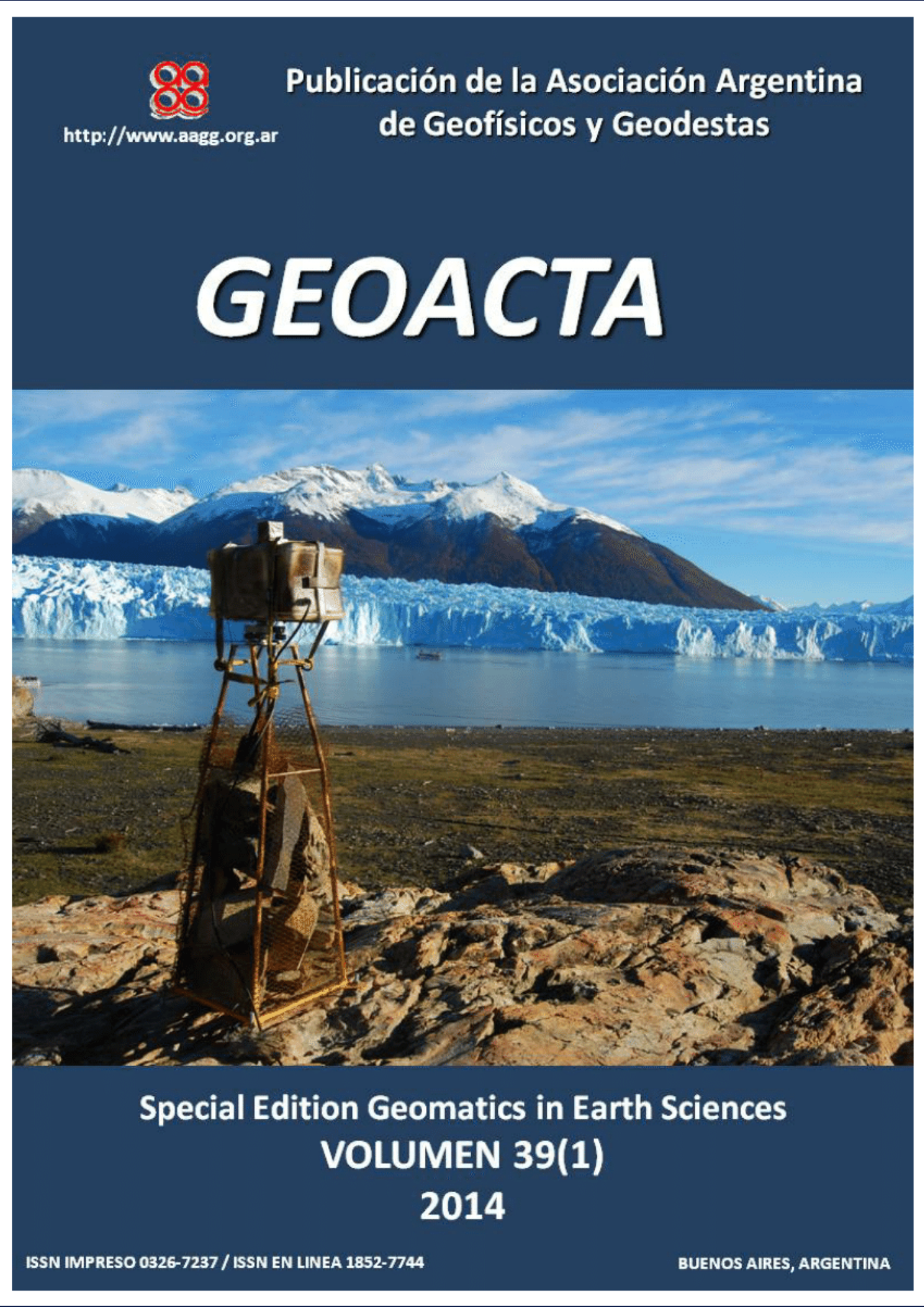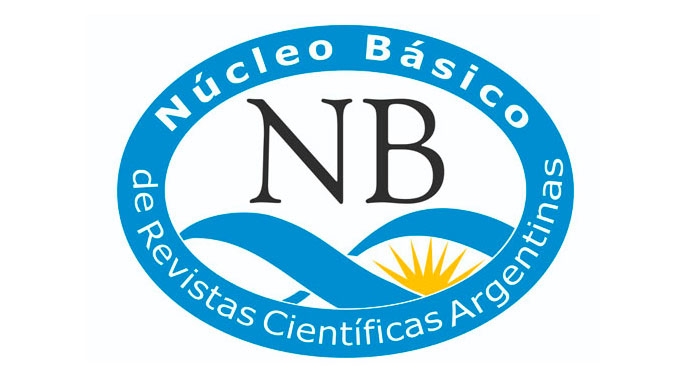Gravimetric method application in the argentine margin
Keywords:
Analytic Signal, tilt, TDR_THDR, COB, 2D gravimetric modelAbstract
The detection of the reflector basalt wedges inclined towards the sea (seaward-dipping-reflectors, SDRs) was a significant finding to determine the edge of the Argentine passive volcanic margin, one that allows determining the continental nature of the crust that contains them. This research develops a tool to demonstrate the natural extension of the continent and the location of the continental and oceanic crust boundary (COB). We implemented two different processes for gravimetric anomalies: i) the application of filters and enhancement techniques to Bouguer anomalies (BA), and ii) 2D gravity modeling. In the first process is applied using the analytical signal (AS), the tilt angle (TDR) and the horizontal gradient of the tilt angle (TDR_THDR). In the second process, we generated a 2D gravity model that allowed for a clear visualization of complex structures in the margin. A joint analysis of 2D modeling and characteristics of the curves obtained from enhancement techniques have identified the COB and extrapolated it to the entire range for its clear delineation.
Downloads
References
Beiki M., (2010). Analytic signals of the gravity gradient tensor and their application to Euler deconvolution. EGM 2010
International Workshop, Adding new value to Electromagnetic, Gravity and Magnetic Methods for Exploration. Capri, Italy, April 11-14.
Brocher T. M., (2005). Empirical relations between elastic wavespeeds and density in the Earth’s crust. Bulletin of the Seismological Society of America, 95 (6): 2081-2092.
Cooper, G.R.J. y Cowan, D.R., (2006). Enhancing potential field data using filters based on the local phase. Computers & Geosciences, 32: 1585–1591.
Franke, D., Neben, S., Ladage, S., Schreckenberger, B., Hinz, K., (2007). Margin segmentation and volcano-tectonic architecture along the volcanic margin off Argentina/Uruguay, South Atlantic. Marine Geology, 244 (1-4): 46–67.
Franke, D., Ladage, S., Schnabel, M., Schreckenberger, B., Reichert, C., Hinz, K., Paterlini, M., de Abelleyra, J., Siciliano, M., (2010). Birth of a volcanic margin off Argentina, South Atlantic. Geochemistry, Geophysics, Geosystems, 11 (2), Q0AB04.
Gardner, G.H.F., Gardner, L., Gregory, A.R., (1974). Formation velocity and density—the diagnostic basics for stratigraphic traps. Geophysics, 39: 770–780.
Ghidella, M.E., Lawver, L.A., Gahagan, L.M., (2007). La Ruptura de Gondwana y la Apertura del Atlántico Sur: Revisión de Modelos de Tectónica de Placas. VI Simposio Argentino y III Latinoamericano sobre Investigaciones Antárticas. Buenos Aires, Argentina, Septiembre 10-14.
Hinz, K., Neben, S., Schreckenberger, B., Roeser, H.A., Block, M., Goncalves De Souza, K., Meyer, H., (1999). The Argentine continental margin north of 48º S: sedimentary successions, volcanic activity during breakup. Marine and Petroleum Geology, 16: 1–25.
Lyatsky H., Pana, D., Olson, R., Godwin, L., (2004). Detection of subtle basement faults with gravity and magnetic data in the Alberta Basin, Canada: A data-use tutorial. The Leading Edge. December 2004: 1282-1288.
Lince Klinger, F., Giménez, M.E., Martínez, M.P. y Introcaso, A., (2008). Las estructuras de la cuenca de Bermejo y sierra de Valle Fértil a partir de los métodos deconvolución de Euler y señal analítica. Revista de la Asociación Geológica Argentina, 63 (2): 281–287.
Miller, H. G., and V. Singh, (1994). Potential field tilt—A new concept for location of potential field sources: Journal of Applied Geophysics, 32: 213–217.
Nabighian, M.N., (1972). The Analytic Signal of Two-dimensional Magnetic Bodies with Polygonal Cross Section: Its Properties and Use for Automated Interpretation. Geophysics, 37: 507–517.
Nabighian, M.N., (1974). Additional comments on the analytic signal of two-dimensional magnetic bodies with polygonal cross section. Geophysics, 39 (1): 85-92.
Nabighian, M.N., (1984). Toward a three-dimensional automatic interpretation of potential field data via generalized Hlíbert translorms: Fundamental relations. Geophysics, 49 (6): 780-786.
Nabighian, M.N., Grauch, V.J.S., Hansen, R.O., LaFehr, T.R., Li, Y., Peirce, J.W., Phillips, J.D., Ruder, M.E., (2005). The historical development of the magnetic method in exploration. Geophysics, 70 (6): 33ND-61ND.
Pizzarro, G., Ruiz, F., Arecco, M.A., Martínez, M.P., Giménez, M.E., (2012). Modelo de moho gravimétrico para las cortezas continental y oceánica argentinas calculado desde datos gravimétricos satelitales. COMTEC, Conferencia Microsoft, Fortaleza, Brasil, Julio 14.
Rabinowitz, P. and J. Labrecque, (1979). The mesozoic South Atlantic ocean and evolution its continental margin. Journal of Geophysical Research, 84 (B11): 5517–6002.
Ramos, V.A., (1996). Evolución tectónica de la Plataforma Continental. Geología y Recursos de la Plataforma Continental, Ramos, V. y Turic, M. (Eds.). Relatorio del XIII° Congreso Geológico Argentino y III° Congreso de Exploración de Hidrocarburos, Asociación Geológica Argentina e Instituto Argentino del Petróleo, 21: 385-404.
Roest W. R., J. Verhoef and M. Pilkington, (1992). Magnetic interpretation using 3-D analytic signal. Geophysics, 57 (1): 116-125.
Ruiz, F. y Introcaso, A., (1999). Un modelo gravimétrico 3D de la profunda cuenca sedimentaria de Ischigualasto-Villa Unión (San Juan y la rioja)-Argentina. Revista Brasileira de Geofísica, 17 (1): 3-11.
Sandwell, D.T. y Smith, W.H.F., (2009). Global marine gravity from retracked Geosat and ERS-1 altimetry: Ridge Segmentation versus spreading rate. Journal of Geophysical. Research, 114, B01411. doi: https://doi.org/10.1029/2008JB006008
Schnabel, M., Franke, D., Engels, M., Hinz, K., Neben, S., Damm, V., Grassmann, S., Pelliza, H., Dos Santos, P.R., (2008).The structure of the lower crust at the Argentine continental margin, South Atlantic at 44°S. Tectonophysics, 454: 14–22.
Talwani, M., Worzel, J.L., Landisman, M., (1959). Rapid Gravity Computations for Two-Dimensional Bodies with. Application to the Mendocino Submarine Fracture Zone. Journal of Geophysical Research, 04 (1): 49-59.
Verduzco, B., Fairhead, J.D., Green, C.M., (2004). New insights into magnetic derivatives for structural mapping. The Leading Edge February: 116-119.
White, R. y McKenzie, D., (1989). Magmatism at Rift Zones: The Generation of Volcanic Continental Margins and Flood Basalts. Journal of Geophysical Research, (94) B6: 7685-7729.
Downloads
Published
How to Cite
Issue
Section
License
Copyright (c) 2014 María Alejandra Arecco, Guillermo Pizarro, Francisco Ruiz

This work is licensed under a Creative Commons Attribution-NonCommercial-ShareAlike 4.0 International License.
Starting in 2022 (Vol. 43 number 2) articles will be published in the journal under a Creative Commons Attribution-NonCommercial-ShareAlike 4.0 International license (CC BY-NC-SA 4.0)
According to these terms, the material can be shared (copied and redistributed in any medium or format) and adapted (remixed, transformed and created from the material another work), provided that a) the authorship and the original source of its publication (journal and URL of the work), b) is not used for commercial purposes and c) the same license terms are maintained.
Prior to this date the articles were published in the journal under a Creative Commons Attribution license (CC BY)
In both cases, the acceptance of the originals by the journal implies the non-exclusive assignment of the economic rights of the authors in favor of the editor, who allows reuse, after editing (postprint), under the license that corresponds according to the edition.
Such assignment means, on the one hand, that after its publication (postprint) in the GEOACTA Magazine of the Association of Geophysicists and Geodesists, the authors can publish their work in any language, medium and format (in such cases, it is requested that it be recorded that the material was originally published in this journal); on the other, the authorization of the authors for the work to be harvested by SEDICI, the institutional repository of the National University of La Plata, and to be disseminated in the databases that the editorial team considers appropriate to increase visibility. of the publication and its authors.
Likewise, the journal encourages the authors so that after their publication in the Journal of the Association of Geophysicists and Geodesists, they deposit their productions in other institutional and thematic repositories, under the principle that offering society scientific production and Unrestricted academic scholarship contributes to a greater exchange of global knowledge.
















